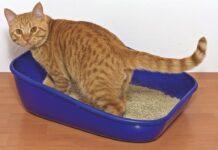Question: I am a sixth grade student doing a science report on cats. I would appreciate information on a cat’s sense of taste, especially on a cat’s taste buds. What else influences what cats like to eat?
Answer: Cats can’t talk to us and tell us what they’re able to taste. Scientists have conducted a number of sophisticated studies to help provide some answers.
Taste buds – the actual taste sensors – are located within special bumps on the surface of the tongue called papillae (singular, papilla). The fungiform, vallate, and foliate papillae have taste buds. The filiform papillae do not have taste buds. These are the bristle-like bumps that make up the rough sandpaper on the cat’s tongue – its hairbrush. Attached to the taste buds are nerves that carry the taste signals to the brain.
Special tasting ability
Cats’ taste buds and ours are a lot alike. Still, things don’t taste quite the same to cats as they do to us. For example, cats cannot taste sweets nearly as well as we do. Since sugar is not part of a cat’s natural diet, this makes sense. On the other hand, cats are able to detect tiny differences in the kinds and amounts of amino acids – the tiny building blocks of proteins – present in their food. This makes sense, too, because cats are carnivores, and proteins constitute a major part of their diet. It is also important for cats to know that their food is fresh, not spoiled; their special tasting ability helps them do that.
The sense of taste is closely linked to the sense of smell. If food doesn’t smell appealing to a cat, he probably won’t even take the first bite, regardless of how good it may taste.
Warm food preferred
The consistency of the food – how it feels in the mouth – is very important too. Cat food manufacturers have learned that even the shape of the food pellet or chunk of canned food influences whether a cat will eat it. The serving temperature of the food makes a difference, especially for canned foods. Studies show that cats prefer food served at close-to-body temperature rather than straight from the refrigerator. The warmer temperature releases more of the odors cats love and more closely resembles the temperature of prey, the cat’s natural diet.
———-
Question: My veterinarian told me that my 11-year-old spayed female cat has colitis. Her bowel movements are frequently covered with mucus and sometimes have streaks of red blood. Occasionally she strains during defecation but otherwise seems fine. We are feeding her a special high-fiber diet, and my veterinarian has given her several kinds of medication, all of which help her temporarily. Although the blood is not present now, I’m afraid that when the medication is discontinued, the condition will appear again. Can we do anything to cure her?
Answer: It’s common for cats with colitis – inflammation of the colon or large bowel – to pass mucus and fresh red blood during defecation. Idiopathic colitis is the term veterinarians use when they cannot determine the exact cause of the colon inflammation. Curing idiopathic colitis is usually not possible, but it can be controlled satisfactorily in most cats. Occasionally, dietary management – for example, food with added fiber or ingredients the cat has not eaten before – might be the answer, but such is not usually the case.
Trial and error
The majority of cases require some form of lifelong medication to keep things under control. Some of the most effective medicines are the cortisone-like drugs (corticosteroids), which the cat may need to take long-term. Corticosteroids tend to be quite safe in cats, especially when tapered down to the lowest dose possible.
Other medications that have been used successfully include sulfasalazine (often given to people with colitis), various antimicrobial medications, and drugs that modify the body’s immune response. Combinations of medications and diet are often more effective than any one thing by itself, so some trial-and-error may be necessary. Because most medications have side effects, your veterinarian will suggest monitoring your cat closely, at least at first.



